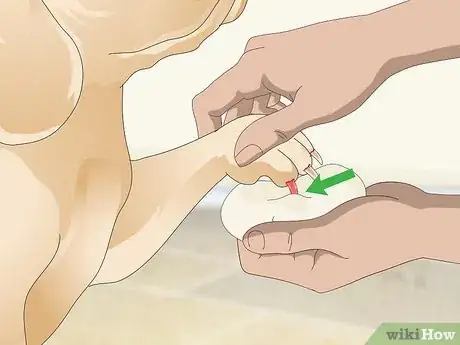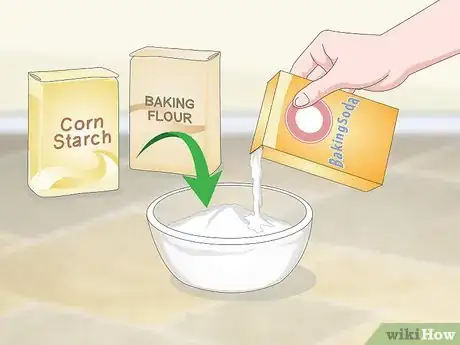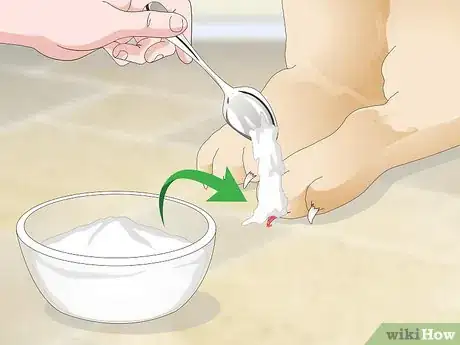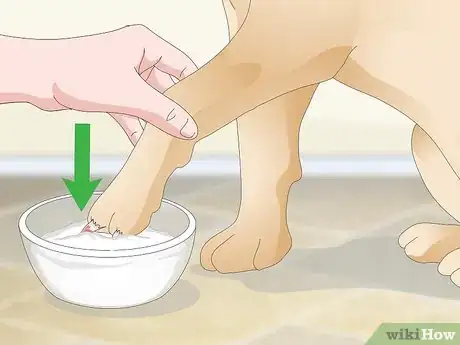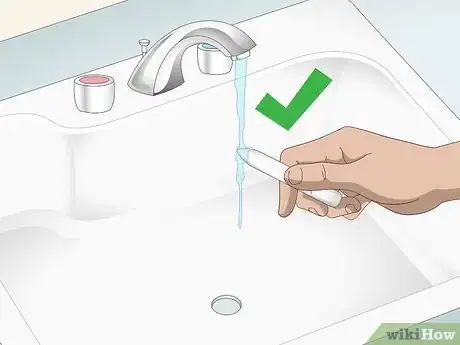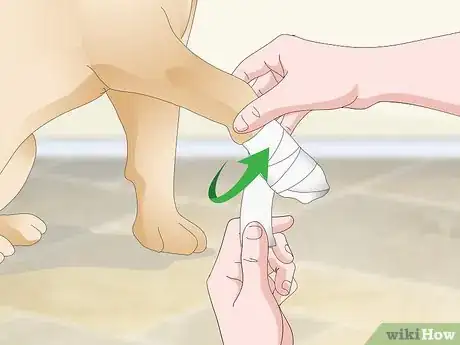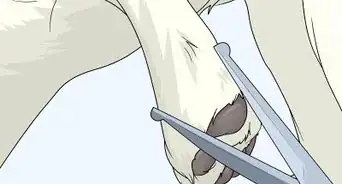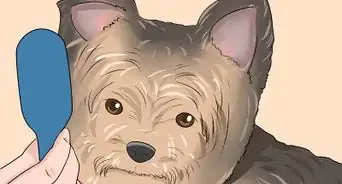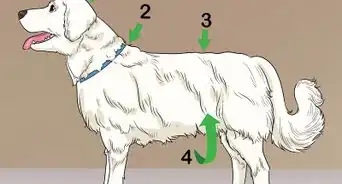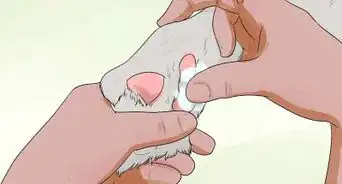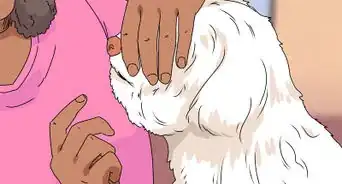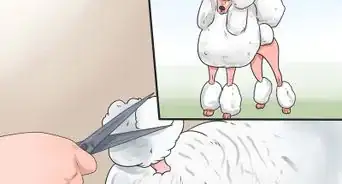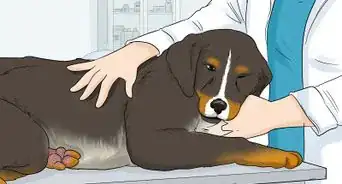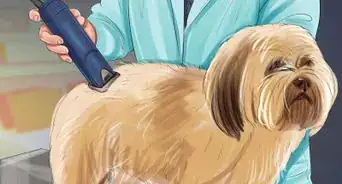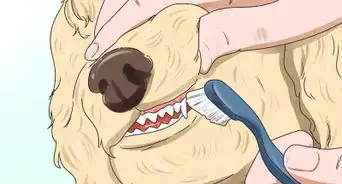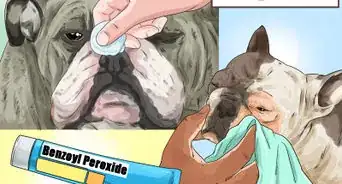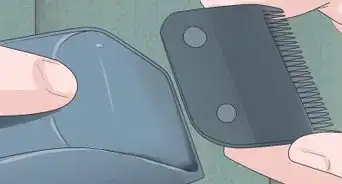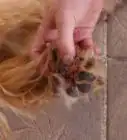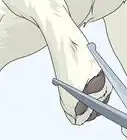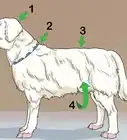This article was co-authored by wikiHow staff writer, Danielle Blinka, MA, MPA. Danielle Blinka is a Writer, Editor, Podcaster, Improv Performer, and Artist currently living in Houston, TX. She also has experience teaching English and writing to others. Danielle holds a Bachelor of Arts in English, Bachelor of Arts in Political Science, Master of Arts in English with a concentration in writing, and Master of Public Administration from Lamar University.
This article has been viewed 57,127 times.
Learn more...
The quick is the part of your pet’s nails that contains the blood vessels and nerves. Most domestic pets, including dogs, cats, birds, rabbits, and other rodents, all have quicks in their nails. Since the quick is a very tender spot, your pet will likely cry out in pain if you cut it. Additionally, the quick will start to bleed, but don’t worry. You can stop the bleeding with common household items like soap and baking soda, but it’s best to use a styptic pencil or powder.
Steps
Using a Bar of Soap
-
1Wet the bar of soap so it’s softer. Hold the soap under running water for a few seconds to get it moist. This will make it easier to use on your pet. However, you may want to hold the soap in a towel or rag so that it’s not slippery.[1]
- If the soap you’re using has been in the bath for a while, you may not need to wet it.
- Any kind of bar soap will work, but you cannot use hand soap to treat your pet’s bleeding quick.
-
2Hold your pet’s foot to keep it steady. It’s best to hold your pet in your lap as you apply the soap. Then, grasp their foot with a firm, but gentle, pressure. Since they’re experiencing discomfort, it’s normal for your pet to want to pull away from you.[2]
- If you can, ask someone to help you apply the soap to your pet’s foot.
Advertisement -
3Press the bleeding nail into the bar of soap. Twist the soap as you push the nail a few millimeters into the bar of soap. Not only will the twisting make the nail go in more easily, it will also coat the nail in a thin layer of soap, which can help stop the bleeding.[3]
- Make sure you aren’t holding onto your pet’s foot too tightly. You don’t want to squeeze its foot while trying to push the nail into the soap, as this can hurt your pet.
-
4Hold the nail in the soap for 2-5 minutes to stop the bleeding. You can check on the nail after 2 minutes to see it's still bleeding. If so, put the nail back into the soap.[4]
- It’s okay if soap is stuck to the end of your pet’s nail. This will help keep the clot in place, and it will eventually rub off of the nail.
- If your pet’s nail is still bleeding after 5-7 minutes, you may need to take them to the vet.
Variation: You may find it easier to scrape the nail against the soap, which creates a thin soap barrier over the quick. Rub the soap over the quick several times to create a soap coating. This should stop the bleeding.
Using Baking Soda, Baking Flour and Cornstarch
-
1Mix baking soda, baking flour, and cornstarch in a bowl. These common household ingredients have a similar effect to clotting powder. Add 1 part baking soda, 1 part baking flour, and 1 part cornstarch, then stir them together.[5]
- When you apply this mixture to your pet’s bleeding quick, it will help the blood clot faster. However, it doesn’t work as well as a styptic pencil or powder.
Variation: If you don’t have all 3 of these powders, you can try just using one. Dip your pet’s quick into plain baking soda, baking flour, or cornstarch, or apply the powder to the nail with a wet cotton swab.[6]
-
2Scoop out a spoonful of the mixture and pour it into your pet’s cut nail. You can also use your hand to scoop the powder. You will likely see a hollow inside the nail, which you will fill with your clotting mixture.[7]
- Don’t worry if most of the powder falls away from the nail. The next step will coat the nail in your homemade clotting powder.
-
3Dip your pet’s nail into the mixture. Hold your pet’s foot as you press the nail into the powder. Make sure the powder covers the entire end of the nail so that the quick is submerged.[8]
- The powder will start to form a paste around the quick, which will help stop the bleeding.
-
4Hold the nail in place for 2 minutes, then check it. Your pet will likely try to pull away, so keep a gentle, but firm, pressure on the foot. After 2 minutes, check to see if the quick is still bleeding.[9]
- Your pet’s nail will likely have powder crusted around the end of the nail, which will help stop the bleeding. Don’t clean off the powder, as this might cause the quick to start bleeding again.
-
5Return a bleeding nail to the clotting powder for up to 5 minutes. If the quick is still bleeding after 2 minutes, press the nail back into the powder for up to 3 additional minutes. Then, check to see if the bleeding has stopped.[10]
- If the quick is still bleeding, you may need to take your pet to the vet.
Applying a Styptic Pencil
-
1Moisten the tip of your styptic pencil. Dip the pencil in water or put it under running water for a few seconds. This will make it easier to apply the pencil to your pet’s quick.[11]
- You can purchase styptic pencils in the human section of your local drug store or online. They’re typically stocked near the shaving supplies.
Variation: You can also use styptic powder, which has the same astringent properties as a styptic pencil. To use the powder, pour a small amount into your pet’s cut nail. Then, dip the nail in the powder for 2 minutes before checking to see if the bleeding has stopped. If the nail is still bleeding, you can hold it in the powder for up to 5 minutes.[12]
-
2Hold your pet’s foot to keep it in place. Use a firm, gentle pressure to control your pet’s foot while you apply the styptic pencil. Otherwise, it will be hard to treat the wound.[13]
- Since your pet will be experiencing discomfort from the cut quick, they may try to wiggle away from you. If you can, ask someone to help you keep them under control.
-
3Apply the styptic pencil against the quick and twist it. Push the end of the styptic pencil onto the bleeding quick. Then, rotate the pencil back and forth to coat the quick. You should see a thin layer forming on the quick.[14]
- The styptic pencil may sting when it’s first applied, so your pet may whimper or try to pull away. However, this sensation should pass after a few minutes.
-
4Check that the bleeding has stopped. Remove the pencil from the quick and look to see if the bleeding has stopped. You will likely see a coating left behind by the styptic pencil, which you should leave in place to help the clot.[15]
- If the quick is still bleeding, you can re-apply the pencil.
-
5Rub the pencil into the quick for up to 5 minutes, if it’s still bleeding. Check the quick every minute or so to see if the bleeding has stopped. If it hasn't stopped after 5 minutes, then you may need to take your pet to the vet.[16]
Getting Veterinary Care
-
1Visit your vet if your pet’s nails are still bleeding after 5-7 minutes. Your pet’s quick should stop bleeding after a few minutes, especially if you used a home treatment to encourage clotting. However, the bleeding may persist, especially if the cut is very high up on the quick. Fortunately, your vet can help clot the wound to stop the bleeding.[17]
-
2Wrap your pet’s foot in a towel or bandage for the trip to the vet. Use a towel or wrap to cover the wound and minimize bleeding. Wrap it firmly around your pet’s foot, but make sure it’s not too tight by sticking your finger underneath the towel or wrap.[18]
- If you can, ask someone to hold the towel or bandage over your pet’s foot during the ride to the vet.
-
3Take your pet to the vet to have the cut nail treated. The vet will apply a specialized clotting agent to the quick, which should stop the bleeding. If your pet is a bird, they may instead decide to cauterize the wound to stop it from bleeding.[19]
- If you’re worried about cutting your pet’s quick again, you may want to get their nails trimmed by the vet or a professional groomer.
Warnings
- Most pets will recover within a few minutes after you cut the quick. However, birds may be in more danger than other pets because their blood doesn’t clot as well. If you cut the quick on your bird’s nails, it’s best to take them to the vet to make sure they don’t bleed too much.[20]⧼thumbs_response⧽
References
- ↑ https://www.puppyleaks.com/dogs-nail-from-bleeding/
- ↑ https://vcahospitals.com/know-your-pet/first-aid-for-bleeding-in-dogs
- ↑ https://vcahospitals.com/know-your-pet/first-aid-for-bleeding-in-dogs
- ↑ https://www.puppyleaks.com/dogs-nail-from-bleeding/
- ↑ https://www.petmd.com/dog/grooming/evr_dg_how_to_trim_a_dogs_toenails
- ↑ https://www.puppyleaks.com/dogs-nail-from-bleeding/
- ↑ https://www.petmd.com/dog/grooming/evr_dg_how_to_trim_a_dogs_toenails
- ↑ https://www.petmd.com/dog/grooming/evr_dg_how_to_trim_a_dogs_toenails
- ↑ https://www.petmd.com/dog/grooming/evr_dg_how_to_trim_a_dogs_toenails
- ↑ https://www.petmd.com/dog/grooming/evr_dg_how_to_trim_a_dogs_toenails
- ↑ https://www.puppyleaks.com/dogs-nail-from-bleeding/
- ↑ https://www.petmd.com/dog/grooming/evr_dg_how_to_trim_a_dogs_toenails
- ↑ https://pets.webmd.com/cats/guide/cat-nail-clipping-care#1
- ↑ https://www.puppyleaks.com/dogs-nail-from-bleeding/
- ↑ https://www.puppyleaks.com/dogs-nail-from-bleeding/
- ↑ https://pets.webmd.com/cats/guide/cat-nail-clipping-care#1
- ↑ https://www.petmd.com/dog/grooming/evr_dg_how_to_trim_a_dogs_toenails
- ↑ https://vcahospitals.com/know-your-pet/first-aid-for-bleeding-in-dogs
- ↑ https://vcahospitals.com/know-your-pet/first-aid-for-bleeding-in-dogs
- ↑ https://vcahospitals.com/know-your-pet/beak-and-nail-care-in-birds


